What Can You Use To Clean Owl Poop Out Of A Deer Stand
How to check Owls for injuries
For pocket-size and medium sized owls simply.
- Checking the owl over.
- What to do if the stomach is empty and the breastbone protruding.
- What to do if the owl is cold or wet.
- Starvation and normal weights.
What if the owl is desperately injured? Do I actually need to cheque it over?
Get-go, do non assume that the owl is badly injured unless you have seen something obvious, such every bit protruding os or bleeding, or information technology has a strong, unpleasant odour. In such cases in that location is little signal in assessing its bodily condition and yous should contact the nearest bachelor bird-experienced vet without delay. If it is apparent that the owl is not badly injured but is surprisingly docile, barely conscious, obviously underweight, very young or active but 'not quite right', it needs assessment before any decision is made. In the case of a nestling owl that appears to be uninjured and is non also thin, it may be far better for you to deal with it and go it back into the nest before the following evening, rather than pass it to someone who may proceed it for an unnecessarily long time. If you lot are not prepared to check the owl over by carefully following all the instructions below y'all must laissez passer it to a vet or wild animals rehabilitator without delay.
Should I article of clothing gloves?
Information technology is advisable to wear thin leather gloves, merely at some phase you will demand to take them off in order to examine the owl properly. If you practice not have an assistant to assist remove your gloves it may be easier non to wear any. This should not exist a problem, provided that you keep the owl's feet nether control and do not heed being pecked a bit!
Warning: if the owl stands more than than 350mm tall and has black and orangish eyes, do not attempt to appraise it yourself every bit it may be an Eagle Owl which should only be handled past an experienced vet or rehabilitator.
Look earlier removing the owl from its container
 When you beginning to uncover or open the container, look to see what position the owl is in. If it is standing facing you, check to see if i wing is held lower than the other – a fly held depression suggests a possible injury to that wing. Notice if both optics open to the same degree or if ane is more open or closed than the other. As well look in the bottom of the box. If the owl has produced a dropping, find what colour it is (white/black is good) and check to meet if it has regurgitated a pellet (a sign that it has eaten recently). Also check to run across if there is any sign of blood. All of the in a higher place are indications of the owl'due south status so make a mental note of any such observations, or, better even so, write them down. Some casualties when stressed will 'pretend' to look fitter than they really are and it is only when quiet and undisturbed that their true country of fitness may be demonstrated. At present option the owl upwards from behind. There is no rush. Take your time. What you lot are going to do adjacent is modify your grip so that you have one mitt free to bank check the owl over.
When you beginning to uncover or open the container, look to see what position the owl is in. If it is standing facing you, check to see if i wing is held lower than the other – a fly held depression suggests a possible injury to that wing. Notice if both optics open to the same degree or if ane is more open or closed than the other. As well look in the bottom of the box. If the owl has produced a dropping, find what colour it is (white/black is good) and check to meet if it has regurgitated a pellet (a sign that it has eaten recently). Also check to run across if there is any sign of blood. All of the in a higher place are indications of the owl'due south status so make a mental note of any such observations, or, better even so, write them down. Some casualties when stressed will 'pretend' to look fitter than they really are and it is only when quiet and undisturbed that their true country of fitness may be demonstrated. At present option the owl upwards from behind. There is no rush. Take your time. What you lot are going to do adjacent is modify your grip so that you have one mitt free to bank check the owl over.
Checking the owl over
 Starting with the owl in both easily, move information technology towards your lower chest, so slowly allow go with i mitt so that the owl is held in one hand against your breast, while keeping the upper part of its legs betwixt your fingers so that the anxiety are pointing abroad to one side.
Starting with the owl in both easily, move information technology towards your lower chest, so slowly allow go with i mitt so that the owl is held in one hand against your breast, while keeping the upper part of its legs betwixt your fingers so that the anxiety are pointing abroad to one side.
Keeping the owl gently pressed confronting you, slowly move the back of the owl onto the palm of your free paw, and then that the back of its caput is on your wrist or forearm.
Follow these instructions:
1. Lay the owl on its back, on the palm of ane hand, with its feet pointing away, the back of its caput resting on your wrist/forearm and with its legs and folded wings encircled past your pollex and alphabetize finger. Practice this firmly but gently so that the owl cannot escape by wriggling nor hurt the handler with its feet.

Tip: if the owl starts to struggle, pull the lesser of your jumper upwardly and over its face, or lay a modest towel or textile over its confront.
2. With your other mitt, move your fingertips slowly and lightly onto its chest and feel its breastbone – the raised bony ridge running down the middle. Feel the breast (the fly muscles) either side of the breastbone. How far does the breastbone stick upwardly above the muscles on either side? A few millimeters is normal; more about 4mm suggests that the owl has been underfed for a significant period.
3. Now run the tips of your fingers right downwardly the breastbone and lightly onto the stomach (the lower role of its forepart, between its legs). Does the tum feel like an empty hollow of loose skin or can you lot feel a solid lump? Does the peel feel warm or common cold?
4. Still with the owl on its dorsum and using your gratuitous hand, concord the leading border of one fly between your thumb and index finger and gently release that fly from the grip of your other paw and then that it tin can exist extended. Sp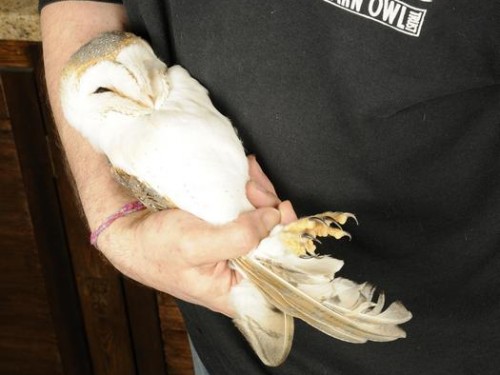 read the wing slightly and with your thumb and index finger hold the leading edge of the fly and feel the bone inside information technology. Slowly feel your mode along each bone (from the body correct down to the base of the furthest wing feather), checking for a swelling, a wet patch, or movement partway along a os. Dislocations are quite common and then call back the corporeality of flexibility in each joint. Check the other wing in an identical way and compare the feel, flexibility, appearance and movement of one wing to the other. When you are quite sure that the wings are identical, or that y'all have found a definite difference, render to the property position (as in footstep 1 above).
read the wing slightly and with your thumb and index finger hold the leading edge of the fly and feel the bone inside information technology. Slowly feel your mode along each bone (from the body correct down to the base of the furthest wing feather), checking for a swelling, a wet patch, or movement partway along a os. Dislocations are quite common and then call back the corporeality of flexibility in each joint. Check the other wing in an identical way and compare the feel, flexibility, appearance and movement of one wing to the other. When you are quite sure that the wings are identical, or that y'all have found a definite difference, render to the property position (as in footstep 1 above).
five. Keeping control of the feet, hold one leg and gently release it from the grip of your other paw and so that information technology can be extended. Feel along each leg bone, over again checking for a swelling, a wet patch, or motility function-style along a bone. Check each leg in turn (be aware of the feet) and compare. Look out for unusual movement or peradventure a lack of movement. When you are quite sure that the legs are identical, or that yous accept found a definite divergence, render to the property position (every bit in step 1 above).

6. Now check the eyes – make sure both optics look the same. If the eyes are closed y'all can gently open each middle in turn; place your index finger against the feathers below one middle, gently residuum your thumb on the upper eyelid and gently motion it upwardly to open the center. Initially, the eye may exist covered past a nictitating membrane (known every bit the third eyelid). Simply await a few moments for this to rise. Both eyes should wait the same. If one eye definitely appears unlike from the other, then a visit to an experienced vet with an ophthalmoscope is needed. Blue centre colouration in some nestling owls is normal (although both eyes should still look the same).
vii. Now check the ears – an owl'southward ear openings are situated on either side of the head between the eyes and the border of the facial deejay and can be found by separating the feathers. It is normal for the size, shape and position of the left and right ears to exist slightly different from each other. All you are really checking for is signs of haemorrhage.

eight. Now check the nostrils and the inside of the beak – the nostrils are small external holes in either side of the upper mandible (nib). Check for haemorrhage. Now you are going to look inside the neb. The easiest way to open the beak is to concur the upper mandible from higher up, betwixt your thumb and index finger and gently push button your thumbnail into the side of the beak between the upper and lower mandibles. A little force may exist necessary at commencement, just never open the neb more than than about 25mm (less for a Little Owl). When the nib opens, keep concord of the upper mandible and use your second finger to hold the lower mandible down or place a finger in the corner of its 'oral cavity' to keep the beak open. Look within the open up gape for signs of bleeding. In a serious collision, the upper mandible sometimes fractures from the skull causing movement between them, but this is very rare. If you meet whatever sign of bleeding or anything else that is obviously not normal, and then the bird needs to be passed to an experienced vet or rehabilitator.
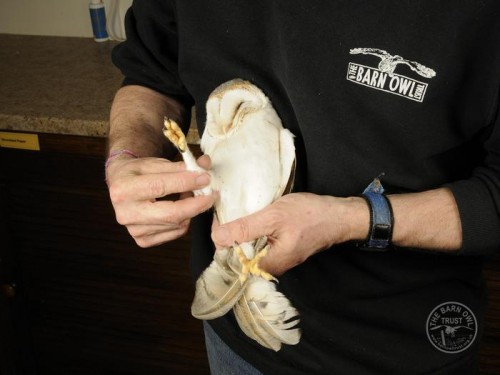
The checking-over process above is the same irrespective of the species of owl you are dealing with or its age. Withal, before deciding what needs to happen side by side, you must detect out what species of owl you are dealing with and whether it is an developed that has been cocky-sufficient in the wild or a young bird that has not. For the purpose of release planning this information is absolutely essential.
Firsthand ACTION
What to do if the stomach is empty and the breastbone is protruding.
If the breadbasket is empty and the breastbone is very protruding (come across checks two and 3 above) then the owl is underweight and probably emaciated. To ostend this you can weigh the owl by placing information technology (in its box) on kitchen scales and subtracting the empty box weight. Bird weights vary according to species (see below) besides every bit size, historic period, sexual practice, time of year and phase of the nesting bicycle. Immediately afterward rearing a brood, a small-scale adult Barn Owl might be perfectly salubrious at 260 g, whereas an unusually big individual may exist dead at this weight. Assessments should always exist based on the physical exam of the individual.
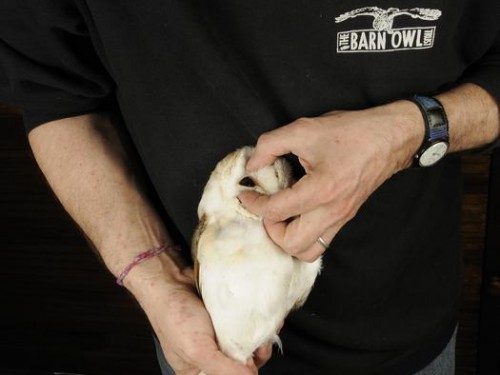
Equally a very crude guide the weights of Barn Owls over six weeks old are:
• Below 250 thousand = emaciated/dead
• 250-290 g = thin
• 290-310 g = okay
• Over 310 g = good
An emaciated owl needs to be tubed by an experienced person. Tubing means giving a specific corporeality of warm h2o and glucose via a syringe and a direct semi-rigid tube of specific length. Do not try this unless yous have the correct equipment and have been shown exactly how to practice it. Accept the bird to an experienced bird rehabilitator every bit before long as possible.
If the owl feels sparse and its weight is less than most 260 yard and it is impossible to go it to a vet or experienced rehabilitator, the priority is to become fluid into the owl followed by food. For at least the first few days the owl is almost unlikely to consume or potable voluntarily; the carer must take full responsibility for its sustenance. For getting fluid in, the bare essentials are a suitable container for the owl, old towels and paper, warm water (ideally with glucose) and a dropper or very small (artist'south/child's) paintbrush. The carer must be prepared to cut up dead mice or poultry chicks, although for the start iii days raw chicken or beef can be used. If yous accept all these things and can spare half an hour roughly every eight hours you tin keep and feed the owl for every bit long equally information technology takes to put sufficient weight on – usually one or two weeks. If you accept significant doubt well-nigh your ability or willingness to exercise this, you should laissez passer the bird to an experienced bird rehabilitator as soon as possible. Instructions for giving fluid and food are provided in Brusk-term intendance of a wild owl.
sustenance. For getting fluid in, the bare essentials are a suitable container for the owl, old towels and paper, warm water (ideally with glucose) and a dropper or very small (artist'south/child's) paintbrush. The carer must be prepared to cut up dead mice or poultry chicks, although for the start iii days raw chicken or beef can be used. If yous accept all these things and can spare half an hour roughly every eight hours you tin keep and feed the owl for every bit long equally information technology takes to put sufficient weight on – usually one or two weeks. If you accept significant doubt well-nigh your ability or willingness to exercise this, you should laissez passer the bird to an experienced bird rehabilitator as soon as possible. Instructions for giving fluid and food are provided in Brusk-term intendance of a wild owl.
What to practise if the owl is cold and/or wet
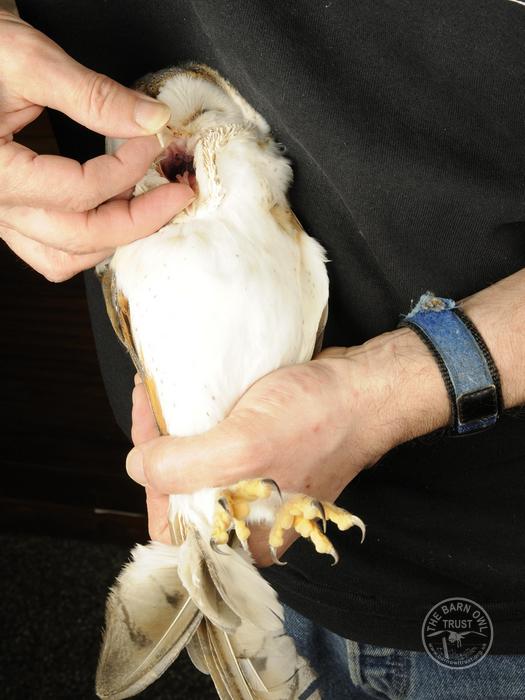 If the stomach is empty and feels common cold, identify the bird in its container somewhere slightly warm and let it warm up for a few hours earlier attempting to feed information technology. If the owl is wet, place it somewhere warm and uncover the box a little so it tin dry off. A saturated owl tin can have over 12 hours to dry and will benefit from a footling extra ventilation, simply not a cold draft. Warmth can exist very skilful for birds that are cold, wet and in daze but exist very conscientious never to dehydrate the owl. Further dehydrating a bird that is already emaciated tin can be fatal. Owls get the fluid they demand from their food and rarely drink; fifty-fifty an owl that is dying of dehydration is almost unlikely to drink. Aim to keep the owl in an air temperature of 15-25°C.
If the stomach is empty and feels common cold, identify the bird in its container somewhere slightly warm and let it warm up for a few hours earlier attempting to feed information technology. If the owl is wet, place it somewhere warm and uncover the box a little so it tin dry off. A saturated owl tin can have over 12 hours to dry and will benefit from a footling extra ventilation, simply not a cold draft. Warmth can exist very skilful for birds that are cold, wet and in daze but exist very conscientious never to dehydrate the owl. Further dehydrating a bird that is already emaciated tin can be fatal. Owls get the fluid they demand from their food and rarely drink; fifty-fifty an owl that is dying of dehydration is almost unlikely to drink. Aim to keep the owl in an air temperature of 15-25°C.
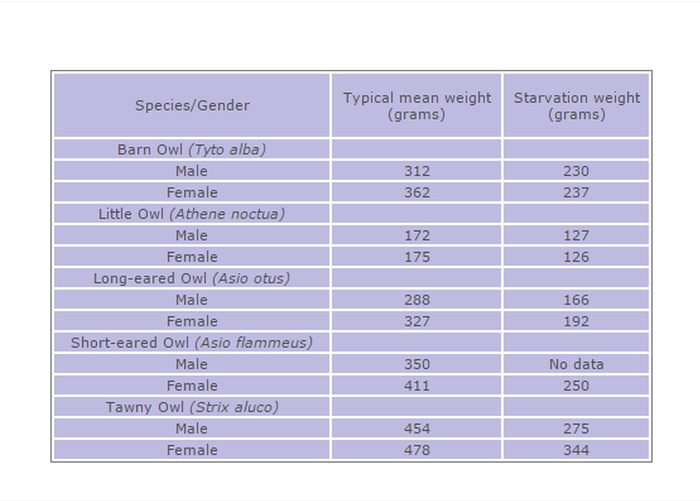
Other relevant pages:
- Observe out whether you lot should pass the owl on, and how you lot go about finding a good rehabilitator.
- If you're sure the owl would not do good from better treatment, better care facilities or better release facilities, find out almost short-term owl care.
- There is more than data on this topic in the Barn Owl Conservation Handbook.
Source: https://www.barnowltrust.org.uk/picking-up-a-live-owl/how-to-check-barn-owls-for-injuries/
Posted by: hornebaginert.blogspot.com


0 Response to "What Can You Use To Clean Owl Poop Out Of A Deer Stand"
Post a Comment